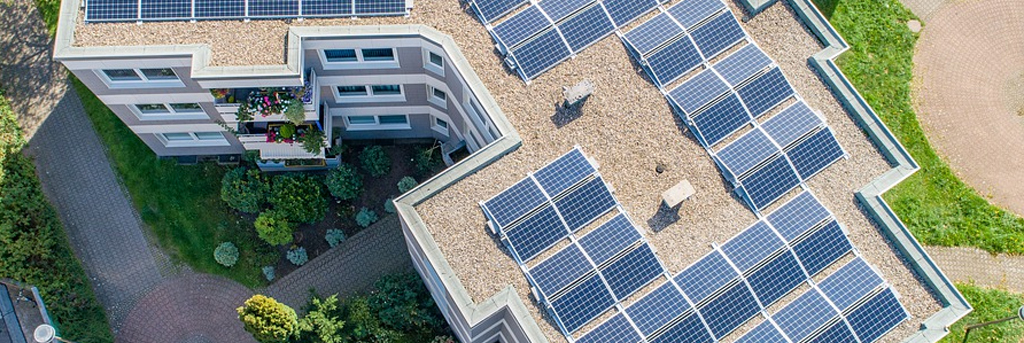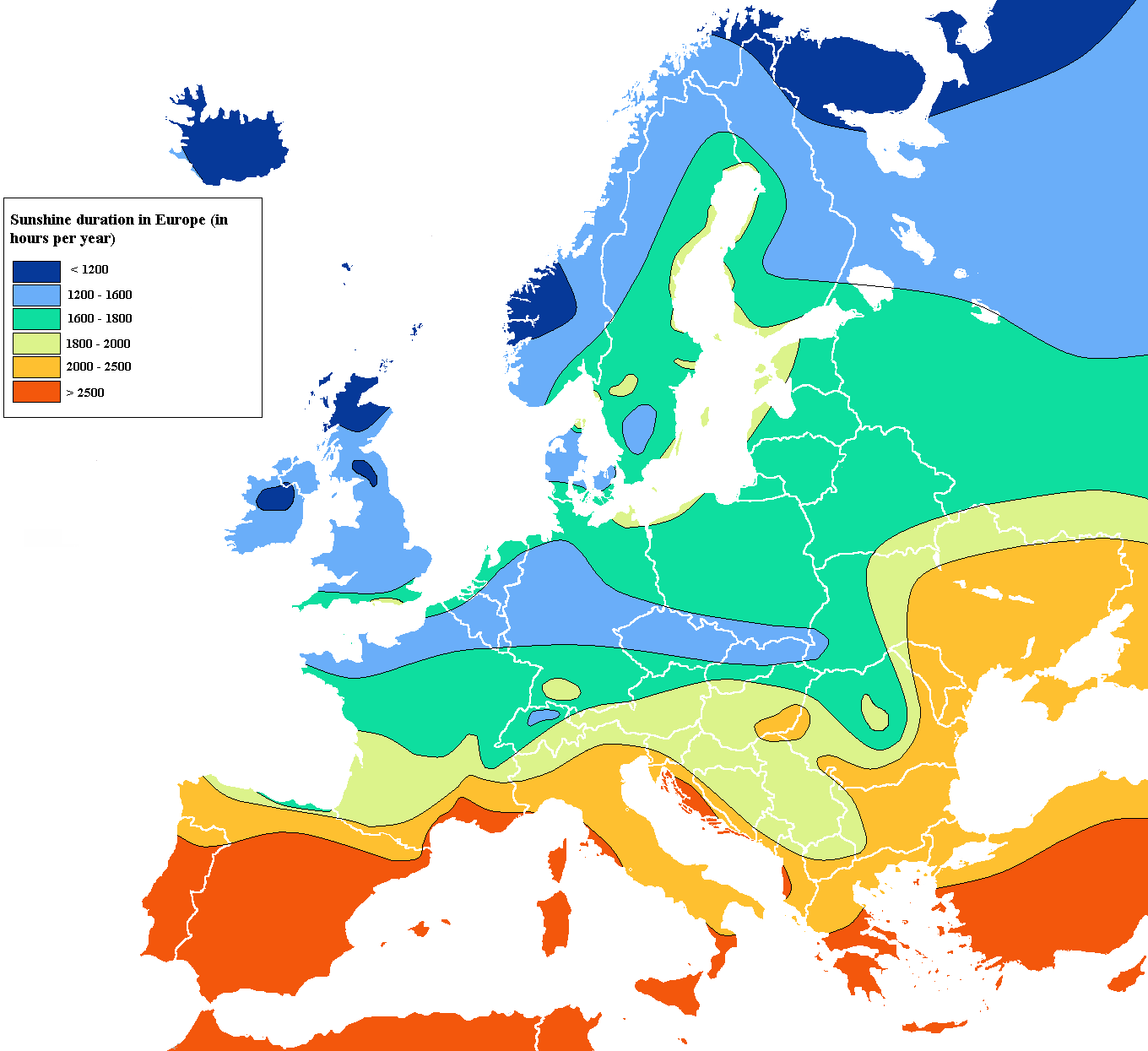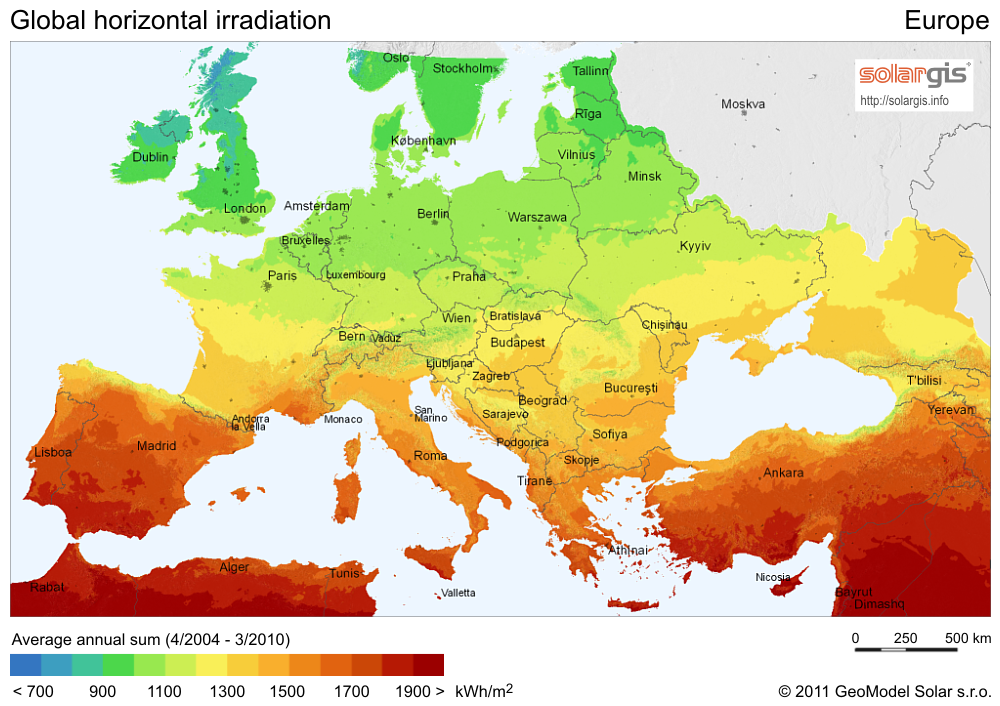
The use of solar energy is the fastest growing amongst renewable energy sources. In 2010 less than 1% of renewable energy came from solar whereby in 2019 this amounted to be more than 8,5%.
Solar power is one of the cleanest renewable energy source available. In general photovoltaics (PV) is the most well known although three primary technologies exist to make use of solar energy:
- photovoltaics (PV) – directly transforming light (from the sun) to electricity
- solar heating and cooling (SHC) systems – collecting thermal energy to provide hot water, or else air heating or conditioning
- concentrating solar power (CSP) – using heat (from the sun) to drive utility-scale, electric turbines

Each technology has its important role in the energy mix. With PV the already existing electricity sector can benefit. By 2018 PV has reached 3.9% of the EU’s gross electricity output.
The EU’s Renewable Energy Directive from 2009 promoted renewable electricity primarily, but in order to achieve de-carbonising objectives, the other technologies especially heating and cooling should also be put in focus.
Heating and hot water is responsible for 79% of final energy use of EU households and although cooling has a much smaller share, with climate change and rising temperatures, the demand is getting higher. In Europe only 19% of heating and cooling is generated from renewable energy.
The Danube Region has a high potential in solar power as the sunshine duration is more than 1800 hours per year in most part of the region.


Since 2005 photovoltaic energy production increased more than 60 times, the SCP energy production increased 200 times and solar heating also more than doubled.
There are of course challenges with renewable energy and thus with solar power also. One of these is energy storage since solar energy depends on sunlight and therefore it cannot work at night as well as in bad weather conditions. There are several solutions already in place to overcome this burden. The price of storage dropped more than 60% since 2014 and by 2030 it is expected to fall another 50%.
Another issue is the structure of electrical grids and load management, but with flexible rules and markets, interconnected transmission networks and other already existing solutions these can be overcome.
According to Eurostat in 2017 3.6% of EU-28 gross electricity generation came from solar power and BloombergNEF predicts that drew on current market trends solar power can cover 20% of the EU electricity demand in 2040.
POLICY BACKGROUND
EU:
- RES directive
- Strategy for heating and cooling
- Energy Efficiency Directive
- Energy performance of buildings directive
Austria:
Bulgaria:
Bosnia and Herzegovina:
- Law on the use of renewable energy sources and efficient cogeneration (Bosnian)
- Law on Renewable Energy
- Legal sources summary
Croatia:
Czech Republic:
Germany:
- Act on the Development of Renewable Energy Sources (Renewable Energy Sources Act – RES Act 2014)
- Legal sources summary
- 2010 Energy Concept (in German only)
- 2030 Climate Action Programme (in German only)
- 2050 Energy Efficiency Strategy (in German only)
Hungary:
Moldova:
- Law of the Republic of Moldova about promotion of energy use from renewable sources
- Legal sources summary
Montenegro:
Romania:
Serbia:
Slovakia:
Slovenia:
Ukraine:
- Law No 810-ІХ “On the Amendments to Certain Laws of Ukraine on Improving the Conditions of Support for Electricity Production from Alternative Energy Sources”
- Legal sources summary
LIBRARY
- Synthesis report on the evaluation of national notifications related to Article 14 of the Energy Efficiency Directive
- Mapping and analyses of the current and future (2020 – 2030) heating/cooling fuel deployment
- Report on EU-27 District Heating and Cooling Potentials, Barriers, Best Practice and Measures of Promotion
- Renewable Power Generation Costs in 2018
- State-of-the-art for assessment of solar energy technologies 2019
- Solar thermal and concentrated solar power barometer 2019
- Smart Grid in the Danube Region Countries An Assessment Report
- Sustainable energy in the Danube region as an integral part of the EU 2020 strategy
- Germany Could Be a Model for How We’ll Get Power in the Future
- Austria solar energy market – growth, trends, and forecast (2020 – 2025)
- Solar energy utilisation opportunities in Bulgaria
- Bulgaria – Renewable Energy
- Developments in Czech renewable energy regulation
- Plan for green energy in Czech Republic
- The solar future Hungary
- Romania solar energy market – growth, trends, and forecast (2020 – 2025)
- Solar energy in Slovakia
- Photovoltaic power plants in Slovenia
- Perspectives of Renewable Energy in the Danube Region – Solar resources
- Energy 2020
- The age of Czech solar power: after years of stagnation, is a rebirth imminent?
- Recent Facts about Photovoltaics in Germany
- Integrated National Energy and Climate Plan for Austria
- State-of-the-art for assessment of solar energy technologies 2019
- Solar thermal and concentrated solar power barometer 2019
- Energy data – 2020 (EUROSTAT)
- SDG 12 – Responsible consumption and production (EUROSTAT article)
- SDG 12 – Responsible consumption and production (EUROSTAT statistical annex)
- EU Market Outlook for Solar Power, 2024–2028
- Engineering, Procurement & Construction Best Practice Guidelines Version 2.0
- European Market Outlook For Battery Storage
- Agri-PV: how solar enables the clean energy transition in rural areas
PROJECTS, BEST PRACTICES
- Austrian-owned Energy BG 1 Ltd. plans to build a solar power plant in the municipality of Haskovo in southern Bulgaria, with an installed capacity of 400 MW.
- Three retail units in total out of 11 will have photovoltaic arrays on top of them, Metro Cash and Carry Bulgaria Food announced at the opening of its first roof power generation system. The project was launched with the installation of over 1,360 panels or 423 kW in Blagoevgrad, in the country’s southwest.
- Green Energy Cooperative (Zelena Energetska Zadruga – ZEZ) has launched the On the Sunny Side campaign for making installation of rooftop photovoltaic solar easier and cheaper for citizens in Croatia. On the Sunny Side targets installation of 1,000 solar power plants by the beginning of 2022.
- Meat processing company Pivac Group has installed a 1.2 MW solar photovoltaic plant on the roofs of its factory PPK Karlovačka Mesna Industrija.
- Sunčane elektrane Međimurja, a firm co-owned by Solvis, Croatia’s sole producer of photovoltaic panels, plans to build the largest solar power plant in the country, with an installed capacity of 50 MW, according to Podravski.hr. The solar power plant, which is expected to cost EUR 40 million, should be located in Rasinja near Koprivnica, the capital of the northern Koprivnica-Križevci county. The planned solar panels with a total capacity of 50 MW would cover an area of some 70 hectares.
- In 2019 Slovenia installed 2,496 solar photovoltaic systems with a total capacity of 31.2 MW of which the vast majority is for self-consumption.
- The Paks Solar Power Plant of the MVM Group, Hungary’s largest currently operating photovoltaic facility. The solar power plant is located in an area of 51 hectares and consists of over 74,000 polycrystalline solar panels.
- The first photovoltaic power plant in Slovenia was set up in 2001. At the end of 2017, 4,231 photovoltaic power plants had been installed in Slovenia with a total power of 267 MW.
USEFUL LINKS
- European Commission (Energy) – https://ec.europa.eu/energy/home_en
- International Renewable Energy Agency (IRENA) – https://www.irena.org/solar
- ESTELA, the European Solar Thermal Electricity Association – https://www.estelasolar.org/about-us/
- International Solar Alliance – https://isa.int/
- Solar Heat Europe – http://solarheateurope.eu/
- European Technology and Innovation Platform for Photovoltaics (ETIP PV) – https://etip-pv.eu/
- European Technology and Innovation Platform on Renewable Heating and Cooling (RHC) – https://www.rhc-platform.org/
- Solar Power Europe – https://www.solarpowereurope.org/
- EUROSTAT (data) – https://ec.europa.eu/eurostat/web/energy/overview
- European Energy Network – https://enr-network.org/
- Association of European Renewable Energy Research Centres (EUREC) – https://eurec.be/
- World Energy portal – https://www.world-energy.org/
